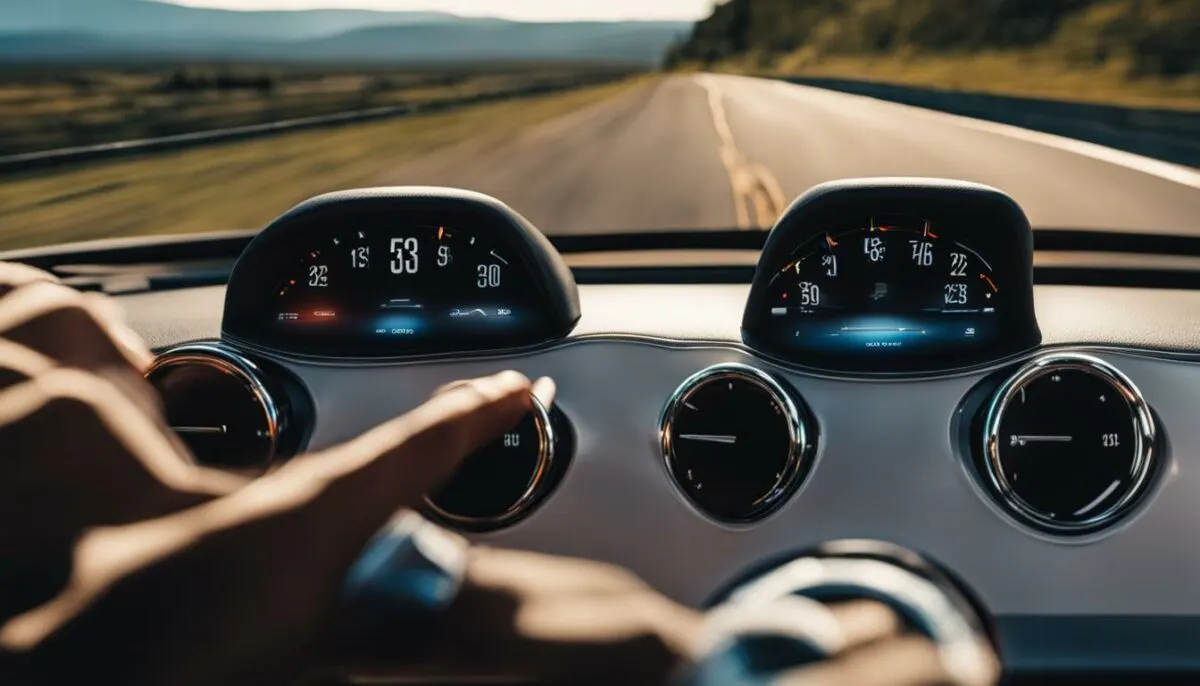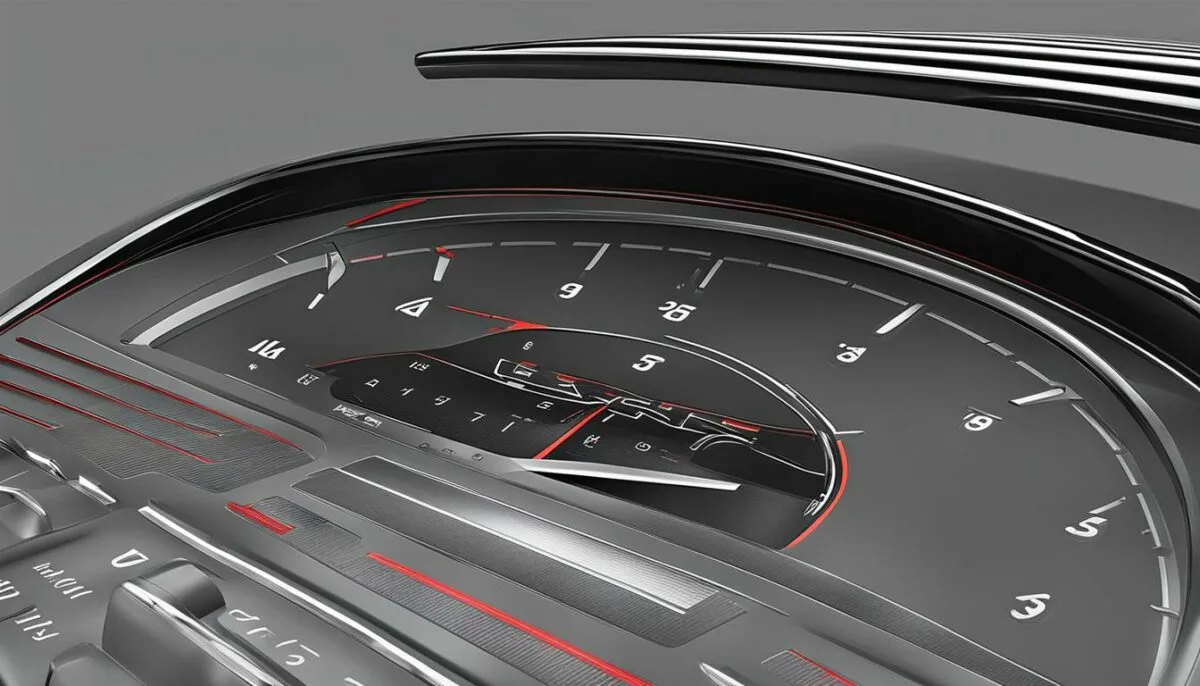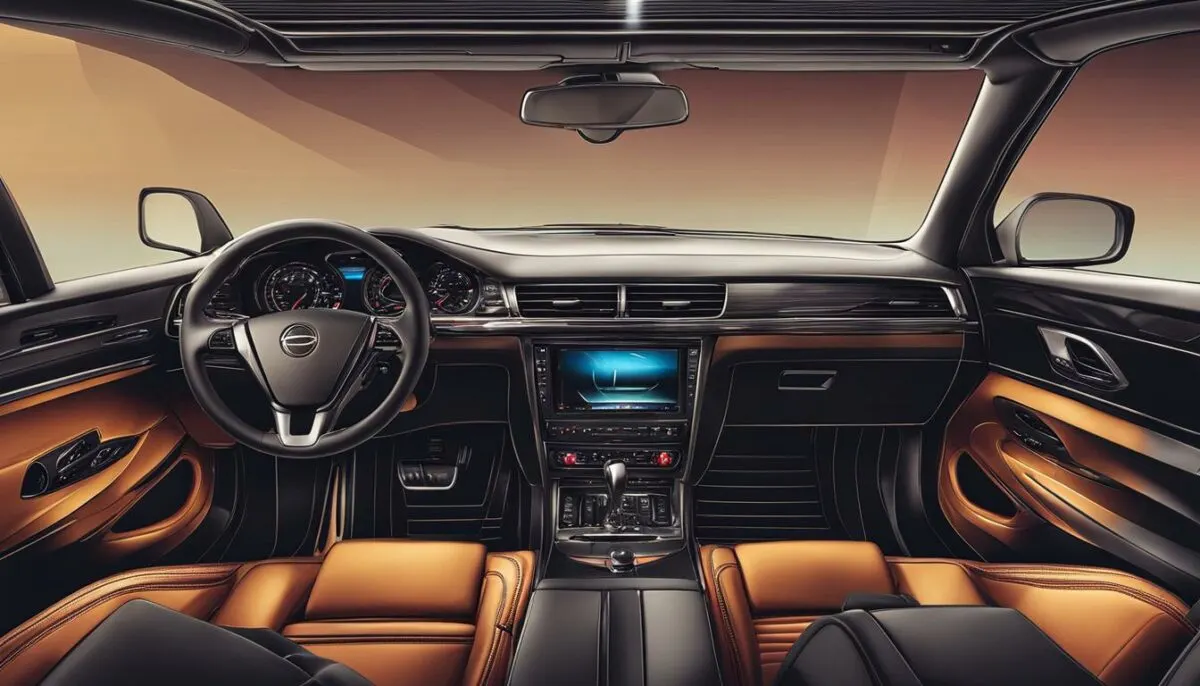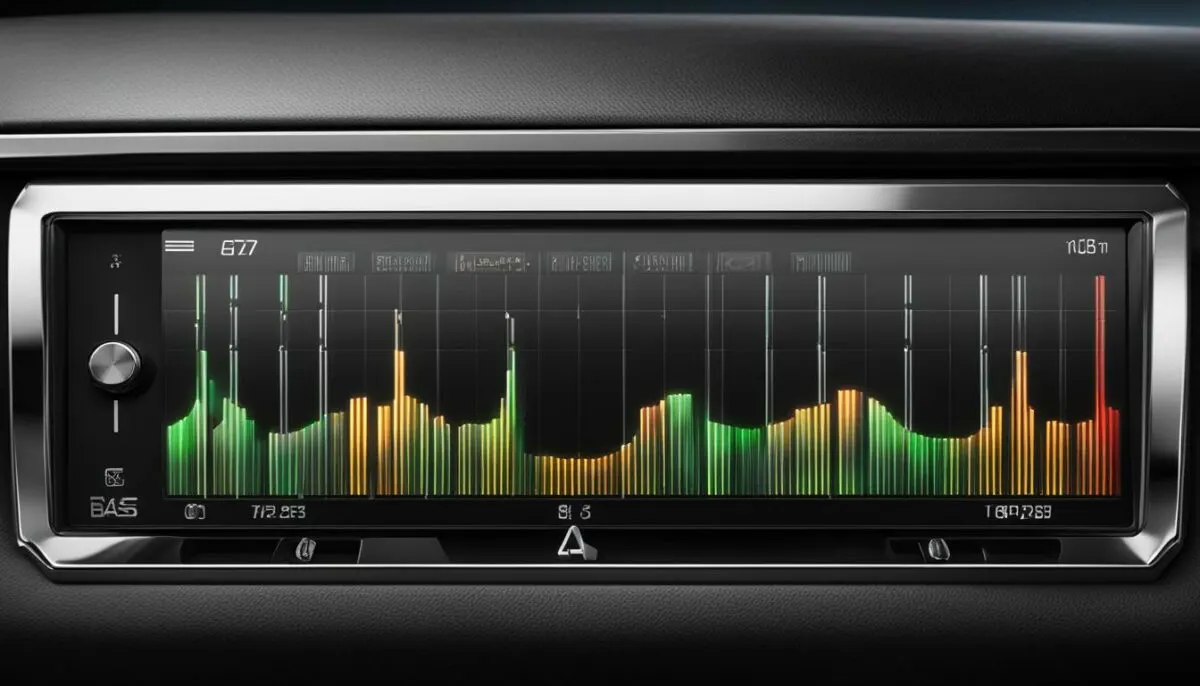Are you tired of lackluster sound quality in your car audio? It’s time to unlock the full potential of your music with the best equalizer settings for car audio bass mid treble. By adjusting the equalizer, you can enhance the bass, midrange, and treble frequencies, providing a well-balanced and superior sound experience.
In this article, we will provide a comprehensive guide on how to adjust the equalizer settings for optimal sound quality in your car. We will walk you through understanding the role of each frequency band, setting the bass for a deep and punchy sound, optimizing the midrange for clarity and presence, tweaking the treble for crisp and detailed highs, and finding the perfect balance between all three. Additionally, we will offer tips on personalizing your sound, considering room and speaker characteristics, testing and refining your settings, and much more.
Key Takeaways:
- Adjusting the equalizer settings can dramatically improve the sound quality of your car audio
- Understanding the role of each frequency band (bass, midrange, treble) is crucial in optimizing the equalizer settings
- Setting the bass for a deep and punchy sound, optimizing the midrange for clarity and presence, and tweaking the treble for crisp and detailed highs are essential for achieving the best equalizer settings
- Personalizing your sound, considering room and speaker characteristics, and testing and refining your settings can further enhance your car audio experience
- With our guide, you can master the art of equalizer settings and drive to the beat of remarkable audio
Understanding the Equalizer Settings
Equalizer settings are used to adjust the balance between different frequencies within your car audio system. By manipulating the bass, midrange, and treble frequencies, you can create a sound profile that is tailored to your preferences. Understanding the role of each frequency band is crucial to achieving the best possible sound.
The Bass Frequencies
Bass frequencies are responsible for adding depth and impact to your music. Increasing the bass can provide a fuller sound. However, too much bass can lead to distortion and overpowering other frequencies. Finding the optimal bass level depends on the type of music you’re listening to and the acoustics of your vehicle.
The Midrange Frequencies
Midrange frequencies are essential for the clarity of vocals and instruments. Adjusting the midrange can create a well-balanced sound by bringing out important elements of the music. Too much midrange can cause the sound to become muddy and indistinct.
The Treble Frequencies
Treble frequencies add sparkle and detail to your music. Increasing the treble can provide crisp, clear highs. However, excessive treble can lead to an unpleasant, shrill sound. Finding the right balance between treble and the other frequencies is vital for creating a pleasant listening experience.
Knowing the role of each frequency band is only the first step. Next, you’ll need to adjust their levels, depending on the type of music you’re listening to and your personal preferences. In the following sections, we’ll provide specific guidance on how to set equalizer settings for bass, mid, and treble frequencies.

Setting the Bass for Deep and Punchy Sound
When you think of car audio, bass is often the first thing that comes to mind. The bass frequencies provide depth and impact, creating a rich and dynamic sound. With the right equalizer settings, you can enhance the bass, achieving a deep and punchy sound that will elevate your car audio experience.
To set the bass on your car audio equalizer, start by playing a song with heavy bass. Then, gradually increase the bass frequency band until you achieve the desired level of depth and impact. Be careful not to overdo it, as too much bass can muddy the sound and overpower the other frequencies.
An optimal EQ setting for bass is usually around 60Hz – 250Hz. This range allows you to boost the lower frequencies without sacrificing clarity. Here is an example of an optimal bass equalizer setting:
| Bass | Mid | Treble |
|---|---|---|
| 8 | 0 | 0 |
Remember that the optimal settings may vary based on personal preferences and the type of music you listen to. It’s important to experiment with different settings until you find what works best for you.
Keep in mind that setting the bass is only one part of the equation. To achieve the best sound quality, you need to balance the bass with the midrange and treble frequencies. In the next sections, we will discuss how to optimize these settings to create a well-balanced sound.
Tip:
If you’re having trouble finding the right bass setting, try adjusting the midrange and treble first. Sometimes, boosting these frequencies can create the illusion of a deeper bass without actually touching the bass frequency band.

Setting the Bass for Deep and Punchy Sound
When it comes to achieving the optimal equalizer settings for car audio, setting the bass frequencies is crucial. That’s because bass provides depth and impact to your music, making it sound fuller and richer. In this section of our car audio equalizer guide, we’ll show you how to adjust the equalizer to enhance the bass, create a deep and punchy sound, and ensure a well-balanced audio experience.
Before we dive into the specific settings, let’s take a moment to understand bass frequencies. Bass is the lowest frequency range, typically between 20Hz to 250Hz. It’s responsible for the deep rumble and thump that you feel in your chest when listening to music. Adjusting the bass frequencies on your car’s equalizer will allow you to control how much of this sound you want to hear.
To set your bass frequencies, start by lowering all of the equalizer bands to their lowest point. Then, play music with a rich bassline and gradually increase the bass frequencies until you achieve the desired balance. Be careful not to overdo it, as too much bass can distort the sound and cause unwanted vibrations.
To achieve the best results, follow these optimal equalizer settings for car audio bass:
| Bass | Mid | Treble |
|---|---|---|
| 5 | 0 | 0 |
These settings are a great starting point for enhancing the bass while maintaining a well-balanced sound. However, every car audio system is unique, and you may need to make further adjustments to suit your personal preferences.
Remember, mastering the art of setting the bass on your car audio equalizer requires patience and experimentation. Take the time to find the right balance, and you’ll be rewarded with a deep and punchy sound that will make your music come alive.
If you want to take your bass frequencies to the next level, consider adding a subwoofer to your car audio system. A subwoofer is a specialized speaker designed to handle low frequencies, providing even more depth and impact to your music.

Tweaking the Treble for Crisp and Detailed Highs
Now that we have covered the bass and midrange, let’s focus on the treble frequencies. The treble adds the sparkle and detail to your music, making it sound crisp and clear.
When adjusting the treble on your car audio equalizer, keep in mind that too much treble can lead to a harsh and piercing sound, while too little can make your music sound dull and lifeless.
Start by setting the treble to the middle or neutral point and listen to a song with various high-pitched elements, such as cymbals or flutes. Gradually increase the treble until the highs sound detailed, but not overwhelmingly sharp.
Some Additional Tips for Tweaking the Treble:
- Use caution when adjusting the treble, as it can easily become too shrill or tinny.
- If your car audio system has a separate setting for high-frequency compression, try using it in conjunction with the treble to achieve a clear and bright sound.
- If you’re unsure how to adjust the treble, consult the user manual for your car audio system or seek professional advice.
By optimizing the bass, midrange, and treble frequencies on your car audio equalizer, you can elevate your music-listening experience to new heights. Experiment with different settings until you find your perfect sound. Don’t forget to test and refine your settings, as the acoustics of your car can affect the sound quality.

Mastering the Art of Balancing the Frequencies
Now that you’ve adjusted the bass and midrange, it’s time to perfect the treble settings. But before doing so, remember to balance the levels for each frequency band to ensure a harmonious sound.
Here’s an example of balanced bass, midrange, and treble settings:
| Bass | Midrange | Treble |
|---|---|---|
| 0 | -1 | +1 |
This table is just an example, and the ideal balance may vary depending on the type of music you prefer and the acoustics of your car. Feel free to experiment with different settings until you find the perfect balance that suits your taste.
It’s important to note that boosting the bass too much at the expense of the midrange and treble can result in a muddy sound. Similarly, boosting the treble excessively can lead to a harsh, tinny tone. Therefore, it’s best to keep the levels of each frequency band in balance.
Once you have achieved a harmonious sound, listen to your favorite song to ensure that the equalizer settings are perfect for your ears. If needed, fine-tune the settings further to make adjustments to achieve the best balance.
Now that you have understood the importance of balancing the frequencies, it’s time to personalize your equalizer settings.

Fine-tuning and Personalizing Your Sound
Now that you have established the optimal equalizer settings for your car audio, it’s time to fine-tune and personalize your sound further. These car audio equalizer tips will enable you to customize your audio to your musical preferences and the acoustics of your vehicle.
Experiment with Different Genres
One of the best ways to personalize your car audio is by experimenting with different music genres. Try out a wide range of music, including rock, pop, hip-hop, classical, and jazz, to get a feel for how your audio system responds to different sounds.
This approach will help you tailor the equalizer settings to suit the nuances of each genre. For example, rock music may benefit from slightly more bass, while classical music may require a more balanced sound across all frequency ranges.
Adjust the Settings for Different Playlists
Another way to customize your audio is by adjusting the equalizer settings for specific playlists. You may have one playlist for upbeat tunes and another for more mellow tracks. By adjusting the equalizer settings for each playlist, you can optimize the sound for the music’s mood and tone.
Some music player apps, such as Spotify, have built-in equalizer settings for different genres, such as rock, jazz, and classical. Experimenting with these settings can help you further fine-tune your audio.
Use Sound Enhancement Apps
There are numerous sound enhancement apps available for both iOS and Android devices, which can help you customize and optimize your car audio.
These apps offer a range of additional features, such as 3D sound, bass boost, and virtual surround sound, that can enhance your music listening experience. Some popular sound enhancement apps include Equalizer FX, AudioFX, and Bass Booster.
Test and Adjust the Settings
Finally, it’s essential to continually test and adjust your equalizer settings to ensure they remain optimal for your car audio.
Take the time to listen to your favorite tracks during different driving conditions, such as highway driving or city streets, to evaluate the audio quality. If necessary, make additional adjustments to balance the bass, midrange, and treble frequencies and maintain a well-balanced sound.
By experimenting with different genres, adjusting the settings for different playlists, using sound enhancement apps, and continually testing and adjusting the settings, you can fully personalize and optimize your car audio equalizer.

Considering Room and Speaker Characteristics
When optimizing your car audio equalizer settings, it’s important to take into account the unique characteristics of your car’s interior and speaker system. By doing so, you can make precise adjustments that will result in the best possible audio quality for your vehicle.
First and foremost, consider the size of your car’s interior. A larger space will require more power to fill with sound, while a smaller space may need less power to avoid overwhelming the listener. Additionally, the shape and material of your car’s interior can affect the way sound travels and is perceived. For example, a car with more carpeting and upholstered surfaces will absorb sound differently than one with hard surfaces like metal or plastic.
Next, consider the speaker system in your car. Are they high-quality speakers, or are they factory-installed and more basic? The type and quality of speakers can affect the way sound is delivered and perceived, and therefore the optimal equalizer settings may vary.
To make accurate adjustments based on these characteristics, start by setting your equalizer to neutral or flat. Then, play a range of music and adjust the bass, midrange, and treble frequencies as needed to achieve the desired sound. Use your ears to guide you, and don’t be afraid to make small adjustments until you find the sweet spot.
Remember, the ultimate goal is to achieve a balanced sound that suits your personal preferences and the unique characteristics of your car. Whether you’re using a factory sound system or a custom setup, understanding and adjusting for these room and speaker characteristics can make a significant difference in your car audio listening experience.

Testing and Refining Your Settings
After setting your equalizer, it’s important to test and refine the settings to ensure you’re getting the best possible sound quality in your car. Here are some tips to help:
1. Use a Reliable Music Source
The quality of your music source can significantly impact the sound quality in your car. Use a reliable source such as a CD or high-quality MP3 file to test your equalizer settings.
2. Test in Different Environments
It’s important to test your equalizer settings in different environments to ensure they work well in any situation. Try testing your settings on the highway, in a parking lot, and in quiet residential areas to get a good sense of how they perform.
3. Make Small Adjustments
When testing your settings, make small adjustments to each frequency band. This will allow you to fine-tune the settings and find the perfect balance between bass, midrange, and treble.
4. Listen Critically
Listen critically to the sound and make note of any areas that may need adjustment. Does the bass sound too heavy? Are the highs too sharp? Use your ears and make adjustments accordingly.
5. Seek Expert Advice
If you’re having trouble finding the perfect equalizer settings for your car, consider seeking expert advice from a car audio professional. They can provide additional tips and guidance to help you achieve optimal sound quality.
By following these tips and testing your settings thoroughly, you can refine your equalizer settings to achieve the perfect sound quality in your car.

Final Thoughts for Best Equalizer Settings for Car Audio Bass Mid Treble
By following the tips outlined in this guide, you can achieve remarkable sound quality in your vehicle. The optimal equalizer settings for car audio bass mid treble will vary depending on your vehicle, music preferences, and room and speaker characteristics. However, by understanding the role of each frequency band, you can adjust the equalizer to create a balanced sound that enhances your music.
Remember to test and refine your settings, making adjustments as necessary. Don’t be afraid to experiment with different settings to find your ideal sound. With a little patience and time, you’ll be on your way to experiencing the best car audio sound possible.
We hope this article has been helpful in guiding you towards finding the best equalizer settings for your car audio bass mid treble. Enjoy the ride with exceptional audio quality!
FAQ
What are the best equalizer settings for car audio bass mid treble?
The best equalizer settings can vary depending on personal preferences and the specific audio system in your car. However, a good starting point is to boost the bass frequencies slightly to enhance depth and impact, adjust the midrange frequencies to bring out clarity and presence, and tweak the treble frequencies for crisp and detailed highs. It’s recommended to experiment with different settings and fine-tune them to achieve your desired sound.
How do I adjust the equalizer settings for bass?
To enhance the bass in your car audio, you can try boosting the lower frequency bands on your equalizer. This will add depth and punch to the sound. However, be cautious not to overdo it, as excessive bass can result in distortion. Start by making small adjustments and listening to the changes in sound until you achieve the desired effect.
What should I do to optimize the midrange frequencies?
Optimizing the midrange frequencies involves adjusting the equalizer settings to bring out the clarity and presence of vocals and instruments. You can try slightly boosting the midrange bands to make them more prominent in the audio mix. Experiment with different settings while listening to music with a wide range of instruments and vocals to find the optimal balance that suits your taste.
How can I tweak the treble for crisp and detailed highs?
Tweaking the treble frequencies on your car audio equalizer can help add sparkle and detail to the high frequencies. You can try gently boosting the treble bands to achieve a crisp and detailed sound. However, be careful not to overdo it, as excessive treble can result in a harsh and fatiguing listening experience. Gradually make adjustments while listening to different genres of music until you find the right balance.
What is the importance of balancing the bass, midrange, and treble frequencies?
Balancing the bass, midrange, and treble frequencies is crucial for achieving an optimal sound experience in your car. Each frequency band plays a unique role in the audio mix, and balancing them ensures a well-rounded and enjoyable listening experience. By finding the right balance, you can create a sound profile that suits your musical preferences and enhances the overall quality of the audio.
How can I personalize my equalizer settings to match my preferences?
Personalizing your equalizer settings is all about tailoring the sound to your specific preferences and musical tastes. Experiment with different settings and adjust the equalizer bands to emphasize or de-emphasize certain frequencies based on the type of music you enjoy. Additionally, take into account the acoustics of your car and how it interacts with the sound. Fine-tuning the settings to suit your preferences will result in a more personalized and immersive audio experience.
Should I consider room and speaker characteristics when adjusting the equalizer settings?
Room and speaker characteristics can have an impact on the overall sound quality and should be taken into consideration when adjusting the equalizer settings in your car. Different vehicles have different acoustics, and speakers can vary in their capabilities. It’s important to listen attentively to how the sound interacts with your car’s interior and make adjustments accordingly. This will help you optimize the equalizer settings for the specific environment and speaker setup, resulting in better sound reproduction.
How should I test and refine my equalizer settings?
After setting your equalizer, it’s important to test and refine the settings to ensure optimal sound quality. Listen to a variety of songs across different genres and pay attention to the balance and clarity of the bass, midrange, and treble frequencies. If something sounds off, make small adjustments to the equalizer bands and listen again until you achieve the desired result. Remember, finding the perfect settings may require some trial and error, so be patient and trust your ears.